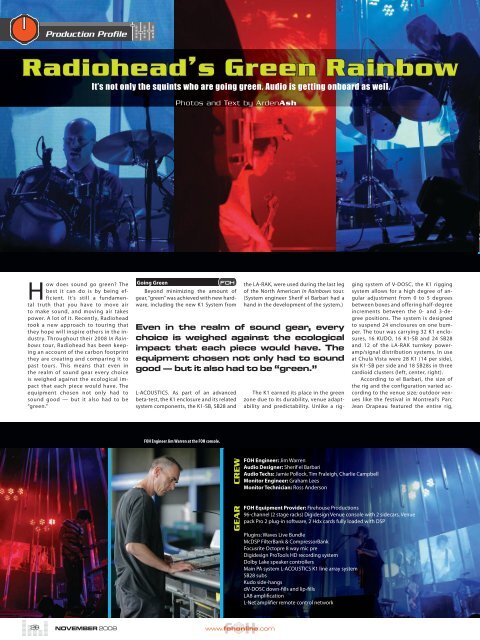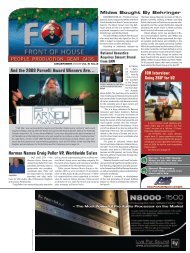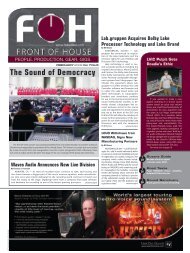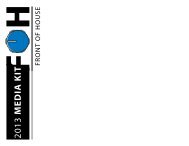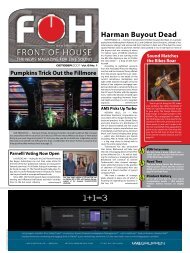Create successful ePaper yourself
Turn your PDF publications into a flip-book with our unique Google optimized e-Paper software.
28<br />
Production Profile<br />
Radiohead’s Green Rainbow<br />
It’s not only the squints who are going green. Audio is getting onboard as well.<br />
How does sound go green? The<br />
best it can do is by being efficient.<br />
It’s still a fundamental<br />
truth that you have to move air<br />
to make sound, and moving air takes<br />
power. A lot of it. Recently, Radiohead<br />
took a new approach to touring that<br />
they hope will inspire others in the industry.<br />
Throughout their 2008 In Rainbows<br />
tour, Radiohead has been keeping<br />
an account of the carbon footprint<br />
they are creating and comparing it to<br />
past tours. This means that even in<br />
the realm of sound gear every choice<br />
is weighed against the ecological impact<br />
that each piece would have. The<br />
equipment chosen not only had to<br />
sound good — but it also had to be<br />
“green.”<br />
Photos and Text by ArdenAsh<br />
Going Green <strong>FOH</strong><br />
Beyond minimizing the amount of<br />
gear, “green” was achieved with new hardware,<br />
including the new K1 System from<br />
L-ACOUSTICS. As part of an advanced<br />
beta-test, the K1 enclosure and its related<br />
system components, the K1-SB, SB28 and<br />
NOVEMBER 2008 www.fohonline.com<br />
the LA-RAK, were used during the last leg<br />
of the North American In Rainbows tour.<br />
(System engineer Sherif el Barbari had a<br />
hand in the development of the system.)<br />
Even in the realm of sound gear, every<br />
choice is weighed against the ecological<br />
impact that each piece would have. The<br />
equipment chosen not only had to sound<br />
good — but it also had to be “green.”<br />
<strong>FOH</strong> Engineer Jim Warren at the <strong>FOH</strong> console.<br />
CREW<br />
GEAR<br />
The K1 earned its place in the green<br />
zone due to its durability, venue adaptability<br />
and predictability. Unlike a rig-<br />
<strong>FOH</strong> Engineer: Jim Warren<br />
Audio Designer: Sherif el Barbari<br />
Audio Techs: Jamie Pollock, Tim Fraleigh, Charlie Campbell<br />
Monitor Engineer: Graham Lees<br />
Monitor Technician: Ross Anderson<br />
ging system of V-DOSC, the K1 rigging<br />
system allows for a high degree of angular<br />
adjustment from 0 to 5 degrees<br />
between boxes and offering half-degree<br />
increments between the 0- and 3-degree<br />
positions. The system is designed<br />
to suspend 24 enclosures on one bumper.<br />
The tour was carrying 32 K1 enclosures,<br />
16 KUDO, 16 K1-SB and 24 SB28<br />
and 12 of the LA-RAK turnkey poweramp/signal<br />
distribution systems. In use<br />
at Chula Vista were 28 K1 (14 per side),<br />
six K1-SB per side and 18 SB28s in three<br />
cardioid clusters (left, center, right).<br />
According to el Barbari, the size of<br />
the rig and the configuration varied according<br />
to the venue size; outdoor venues<br />
like the festival in Montreal’s Parc<br />
Jean Drapeau featured the entire rig,<br />
<strong>FOH</strong> Equipment Provider: Firehouse Productions<br />
96-channel (2 stage racks) Digidesign Venue console with 2 sidecars, Venue<br />
pack Pro 2 plug-in software, 2 Hdx cards fully loaded with DSP<br />
Plugins: Waves Live Bundle<br />
McDSP FilterBank & CompressorBank<br />
Focusrite Octopre 8 way mic pre<br />
Digidesign ProTools HD recording system<br />
Dolby Lake speaker controllers<br />
Main PA system L-ACOUSTICS K1 line array system<br />
SB28 subs<br />
Kudo side-hangs<br />
dV-DOSC down-fills and lip-fills<br />
LA8 amplification<br />
L-Net amplifier remote control network


